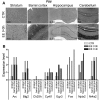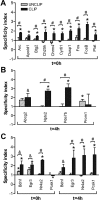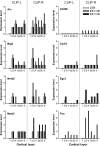Genomewide analysis of rat barrel cortex reveals time- and layer-specific mRNA expression changes related to experience-dependent plasticity
- PMID: 21508239
- PMCID: PMC6632955
- DOI: 10.1523/JNEUROSCI.6514-10.2011
Genomewide analysis of rat barrel cortex reveals time- and layer-specific mRNA expression changes related to experience-dependent plasticity
Abstract
Because of its anatomical organization, the rodent whisker-to-barrel system is an ideal model to study experience-dependent plasticity. Manipulation of sensory input causes changes in the properties of the barrels at the physiological, structural, and functional levels. However, much less is known about the molecular events underlying these changes. To explore such molecular events, we have used a genomewide approach to identify key genes and molecular pathways involved in experience-induced plasticity in the barrel cortex of adult rats. Given the natural tendency of rats to explore novel objects, exposure to an enriched environment (EE) was used to stimulate the activity of the whisker-to-barrel cortex in vivo. Microarray analysis at two different time points after EE revealed differential expression of genes encoding transcription factors, including nuclear receptors, as well as of genes involved in the regulation of synaptic plasticity, cell differentiation, metabolism, and, surprisingly, blood vessel morphogenesis. These expression differences reflect changes in somatosensory information processing because unilateral whisker clipping showed EE-induced differential expression patterns in the spared versus deprived barrel cortex. Finally, in situ hybridization revealed cortical layer patterns specific for each selected gene. Together, the present study offers the first genomewide exploration of the key genes regulated by somatosensory stimulation in the barrel cortex and thus provides a solid experimental framework for future in-depth analysis of the mechanisms underlying experience-dependent plasticity.
Figures









Similar articles
-
Sleep modifies glutamate decarboxylase mRNA within the barrel cortex of rats after a mystacial whisker trim.Sleep. 2001 May 1;24(3):261-6. doi: 10.1093/sleep/24.3.261. Sleep. 2001. PMID: 11322707
-
Anatomical pathways and molecular mechanisms for plasticity in the barrel cortex.Neuroscience. 2002;111(4):799-814. doi: 10.1016/s0306-4522(02)00027-1. Neuroscience. 2002. PMID: 12031405 Review.
-
Time course of experience-dependent synaptic potentiation and depression in barrel cortex of adolescent rats.J Neurophysiol. 1996 Apr;75(4):1714-29. doi: 10.1152/jn.1996.75.4.1714. J Neurophysiol. 1996. PMID: 8727408
-
Experience-dependent plasticity is impaired in adult rat barrel cortex after whiskers are unused in early postnatal life.J Neurosci. 2003 Jan 1;23(1):358-66. doi: 10.1523/JNEUROSCI.23-01-00358.2003. J Neurosci. 2003. PMID: 12514235 Free PMC article.
-
The functional organization of the barrel cortex.Neuron. 2007 Oct 25;56(2):339-55. doi: 10.1016/j.neuron.2007.09.017. Neuron. 2007. PMID: 17964250 Review.
Cited by
-
Experience-dependent plasticity in early stations of sensory processing in mature brains: effects of environmental enrichment on dendrite measures in trigeminal nuclei.Brain Struct Funct. 2022 Apr;227(3):865-879. doi: 10.1007/s00429-021-02424-3. Epub 2021 Nov 22. Brain Struct Funct. 2022. PMID: 34807302 Free PMC article.
-
BDNF Therapeutic Mechanisms in Neuropsychiatric Disorders.Int J Mol Sci. 2022 Jul 29;23(15):8417. doi: 10.3390/ijms23158417. Int J Mol Sci. 2022. PMID: 35955546 Free PMC article. Review.
-
Activity-dependent plasticity and gene expression modifications in the adult CNS.Front Mol Neurosci. 2011 Nov 28;4:50. doi: 10.3389/fnmol.2011.00050. eCollection 2011. Front Mol Neurosci. 2011. PMID: 22144945 Free PMC article.
-
MicroRNA-137 regulates a glucocorticoid receptor-dependent signalling network: implications for the etiology of schizophrenia.J Psychiatry Neurosci. 2014 Sep;39(5):312-20. doi: 10.1503/jpn.130269. J Psychiatry Neurosci. 2014. PMID: 24866554 Free PMC article.
-
Optimization of Experimental Parameters in Data-Independent Mass Spectrometry Significantly Increases Depth and Reproducibility of Results.Mol Cell Proteomics. 2017 Dec;16(12):2296-2309. doi: 10.1074/mcp.RA117.000314. Epub 2017 Oct 25. Mol Cell Proteomics. 2017. PMID: 29070702 Free PMC article.
References
-
- Ahissar E, Sosnik R, Haidarliu S. Transformation from temporal to rate coding in a somatosensory thalamocortical pathway. Nature. 2000;406:302–306. - PubMed
-
- Albrecht C, von Der Kammer H, Mayhaus M, Klaudiny J, Schweizer M, Nitsch RM. Muscarinic acetylcholine receptors induce the expression of the immediate early growth regulatory gene CYR61. J Biol Chem. 2000;275:28929–28936. - PubMed
-
- Bisler S, Schleicher A, Gass P, Stehle JH, Zilles K, Staiger JF. Expression of c-Fos, ICER, Krox-24 and JunB in the whisker-to-barrel pathway of rats: time course of induction upon whisker stimulation by tactile exploration of an enriched environment. J Chem Neuroanat. 2002;23:187–198. - PubMed
Publication types
MeSH terms
Substances
LinkOut - more resources
Full Text Sources
